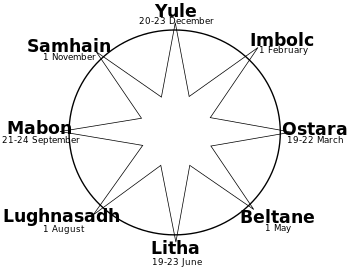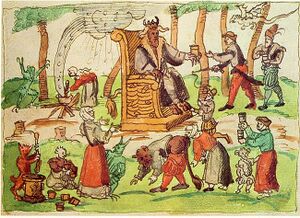عجلة السنة

عجلة السنة Wheel of the Year هي دورة سنوية من الأعياد الموسمية، observed by many modern Pagans, consisting of the year's chief solar events (solstices and equinoxes) and the midpoints between them. While names for each festival vary among diverse pagan traditions, syncretic treatments often refer to the four solar events as "quarter days" and the four midpoint events as "cross-quarter days", particularly in Wicca. Differing sects of modern Paganism also vary regarding the precise timing of each celebration, based on distinctions such as lunar phase and geographic hemisphere.
Observing the cycle of the seasons has been important to many people, both ancient and modern. Contemporary Pagan festivals that rely on the Wheel are based to varying degrees on folk traditions, regardless of actual historical pagan practices.[1] Among Wiccans, each festival is also referred to as a sabbat ( /ˈsæbət/), based on Gerald Gardner's claim that the term was passed down from the Middle Ages, when the terminology for Jewish Shabbat was commingled with that of other heretical celebrations.[2] Contemporary conceptions of the Wheel of the Year calendar were largely influenced by mid-20th century British Paganism.
. . . . . . . . . . . . . . . . . . . . . . . . . . . . . . . . . . . . . . . . . . . . . . . . . . . . . . . . . . . . . . . . . . . . . . . . . . . . . . . . . . . . . . . . . . . . . . . . . . . . . . . . . . . . . . . . . . . . . . . . . . . . . . . . . . . . . . . . . . . . . . . . . . . . . . . . . . . . . . . . . . . . . . . .
الأصول
Historical and archaeological evidence suggests ancient pagan and polytheist peoples varied in their cultural observations; Anglo-Saxons celebrated the solstices and equinoxes, while Celts celebrated the seasonal divisions with various fire festivals.[3] In the 10th century Cormac Mac Cárthaigh wrote about "four great fires...lighted up on the four great festivals of the Druids...in February, May, August, and November."[4]
The contemporary Neopagan festival cycle, prior to being known as the Wheel of the Year, was influenced by works such as The Golden Bough by James George Frazer (1890) and The Witch-Cult in Western Europe (1921) by Margaret Murray. Frazer claimed that Beltane (the beginning of summer) and Samhain (the beginning of winter) were the most important of the four Gaelic festivals mentioned by Cormac. Murray used records from early modern witch trials, as well as the folklore surrounding European witchcraft, in an attempt to identify the festivals celebrated by a supposedly widespread underground pagan religion that had survived into the early modern period. Murray reports a 1661 trial record from Forfar, Scotland, where the accused witch (Issobell Smyth) is connected with meetings held "every quarter at Candlemas, Rud−day, Lambemas, and Hallomas."[5] In The White Goddess (1948) Robert Graves claimed that, despite Christianization, the importance of agricultural and social cycles had preserved the "continuity of the ancient British festal system" consisting of eight holidays: "English social life was based on agriculture, grazing, and hunting" implicit in "the popular celebration of the festivals now known as Candlemas, Lady Day, May Day, Midsummer Day, Lammas, Michaelmas, All-Hallowe'en, and Christmas; it was also secretly preserved as religious doctrine in the covens of the anti-Christian witch-cult."[6]
الأعياد

انظر أيضاً
- Ember days
- List of Neo-Pagan festivals and events
- Medicine wheel, metaphor for a variety of Native American spiritual concepts
- Solar terms, year's divisions in China and East Asia
التقاويم
الهامش
- ^ Harvey, Graham (1994). "The Roots of Pagan Ecology". Journal of Contemporary Religion. 9 (3): 38–41. doi:10.1080/13537909408580720.
- ^ Gardner, Gerald (1954). Witchcraft Today. p. 147.
- ^ Hutton, Ronald (8 December 1993), The Pagan Religions of the Ancient British Isles, Oxford, Blackwell, pp. 337–341, ISBN 0-631-18946-7
- ^ Murray, Margaret. 1931. The God of the Witches.
- ^ Kinloch, George Ritchie. Reliquiae Antiquae Scoticae. Edinburgh, 1848.
- ^ Robert Graves, The White Goddess, New York: Creative Age Press, 1948. Published in London by Faber & Faber.


